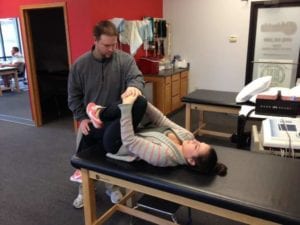Low back pain is, unfortunately, a nuisance that most adults will have to deal with at some point in their lives. The onset of pain may creep up slowly over time, with no discernable triggering event. Other times, however, you can pinpoint exactly where you were and what you were doing when the pain began. For instance, maybe you were trying to lift something heavy that you’ve never lifted before when you felt a sudden sharp twinge of pain in your low back. You hopefully stopped what you were doing at that moment, and in the next few days avoided activities that aggravated your pain. But what happens if that pain doesn’t go away after a few days of rest? Concerned that you may have inflicted some serious damage on your spine, you would probably schedule an appointment with your doctor. After a quick exam, your doctor sends you on your way with the diagnosis of “lumbar strain” and a referral to physical therapy. But what exactly is a lumbar strain, and what can a physical therapist do about it?
In simple terms, a muscle strain occurs whenever a muscle is stretched beyond its capacity, resulting in trauma and tearing of the tissue. The mechanical trauma of the tear triggers pain and inflammation. The initial pain response is a helpful message to your brain that says, “Hey, I’m injured! Stop what you’re doing.” The inflammation response is essentially a rush of blood cells to the area, to begin the work of repair. Our bodies are remarkably good at repairing themselves after injury, but sometimes they need a little bit of coaching. Furthermore, an injury is often the result of an underlying mechanical problem, such as muscle weakness or poor body mechanics. As physical therapists, our role is to perform a thorough evaluation that goes beyond determining just where the pain is coming from. While it is important for us to know where your pain is, it is even more valuable to you as a patient if we can determine what caused the pain in the first place. And, most of the time, the answer is not as simple as, “I lifted something too heavy.”
Let’s take a golfer for example. Performing a golf swing requires a large rotational movement of the spine. The spine is separated into three segments: cervical (neck), thoracic (mid-back), and lumbar (low back). Each segment is designed to perform different degrees of rotation during trunk movements. The thoracic spine should handle most of the rotation, with very little rotation meant to be occurring at the lumbar spine. If a golfer is limited in thoracic mobility, however, he or she may try to compensate with excessive lumbar rotation, which overloads the low back, thus paving the way for injury. Even your hips can be the culprit of a low back injury. A good example of this can be found in the weight room of a gym. Swinging or deadlifting a kettlebell without sufficient hip flexibility can force your low back into excessive extension, making it more vulnerable to injury.
When it comes to any type of muscle injury, your body will naturally attempt to heal on its own. However, if we don’t address all the underlying issues that can predispose you to an injury, chances are pretty high that you’ll end up with another episode of pain down the road. By understanding how the spine works under optimal circumstances, a physical therapist is trained to identify irregular movement patterns and muscles that are performing “sub-optimally”. Finding and correcting these abnormalities will better ensure that you make both a full and permanent recovery.
Samantha Dumesnil PT, DPT

